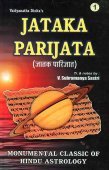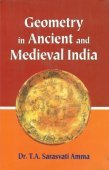Jyotisha, Jyotiṣa: 22 definitions
Introduction:
Jyotisha means something in Buddhism, Pali, Hinduism, Sanskrit, the history of ancient India, Marathi, Hindi. If you want to know the exact meaning, history, etymology or English translation of this term then check out the descriptions on this page. Add your comment or reference to a book if you want to contribute to this summary article.
The Sanskrit term Jyotiṣa can be transliterated into English as Jyotisa or Jyotisha, using the IAST transliteration scheme (?).
In Hinduism
Purana and Itihasa (epic history)
Source: archive.org: Puranic EncyclopediaJyotiṣa (ज्योतिष).—(Astronomy and astrology). Jyotiṣa is the science about the stars and heavenly bodies. The heavenly bodies are the sun, the moon, the other planets and the stars etc. From the very ancient days men believed that these planets and stars in the sky played an important part in controlling the growth and activities of all the living and non-living things in the world.
Astrology has been a recognized science in Egypt, China and India from very ancient days. History tells us that 3000 years before Christ there were astronomers in Babylon. But even before that time astronomy had fully expanded and grown in Bhārata. (See full article at Story of Jyotiṣa from the Puranic encyclopaedia by Vettam Mani)
Source: Cologne Digital Sanskrit Dictionaries: The Purana IndexJyotiṣa (ज्योतिष).—The science of Astronomy begins in Dvāpara;1 a part of Viṣṇu;2 attributed to Garga who learnt it from Śeṣa.3
- 1) Matsya-purāṇa 144. 22; Vāyu-purāṇa 66. 52.
- 2) Viṣṇu-purāṇa V. 1. 37.
- 3) Bhāgavata-purāṇa X. 8. 5; Brahmāṇḍa-purāṇa II. 21. 36; 22. 3; III. 5. 80; Viṣṇu-purāṇa II. 5. 26.

The Purana (पुराण, purāṇas) refers to Sanskrit literature preserving ancient India’s vast cultural history, including historical legends, religious ceremonies, various arts and sciences. The eighteen mahapuranas total over 400,000 shlokas (metrical couplets) and date to at least several centuries BCE.
Arthashastra (politics and welfare)
Source: Shodhganga: Kakati Ganapatideva and his times (artha)Jyotiṣa (ज्योतिष, “astrologer”) is an official title designating one of the seventy-two officers (niyoga) of the Bāhattaraniyogādhipati circle, according to the Inscriptional glossary of Andhra Pradesh (Śāsana-śabdakośāmu). The bāhattaraniyoga-adhipati is the highest executive officer of this circle (including a Jyotiṣa). For example: During the reign of Gaṇapatideva, the area extending between Pānagal to Mārjavāḍi was entrusted to Gaṇḍapeṇḍāru Gangayasāhiṇi as Bāhattaraniyogādhipati. Later on, this office was entrusted to Kāyastha Jannigadeva.

Arthashastra (अर्थशास्त्र, arthaśāstra) literature concerns itself with the teachings (shastra) of economic prosperity (artha) statecraft, politics and military tactics. The term arthashastra refers to both the name of these scientific teachings, as well as the name of a Sanskrit work included in such literature. This book was written (3rd century BCE) by by Kautilya, who flourished in the 4th century BCE.
Jyotisha (astronomy and astrology)
Source: Wisdom Library: Brihat Samhita by Varahamihira1) Jyotiṣa (ज्योतिष) or Jyotiṣaka refers to an “astrologer” (one who is versed in Saṃhita, Astronomy and Horoscopy), according to the Bṛhatsaṃhitā (chapter 2), an encyclopedic Sanskrit work written by Varāhamihira mainly focusing on the science of ancient Indian astronomy astronomy (Jyotiṣa).—Accordingly, “We shall now proceed to give a brief description of (the qualifications of) a jyotiṣaka. He must be of noble birth and of agreeable appearance; meek, truthful and without jealousy; of proportional limbs; of joints well built and of good growth; have no physical defects; be of fine hands, feet, nails, eyes, chin, teeth, ears, forehead, eye-brows and head; of fine physique and of high, sonorous voice”.
2) Jyotiṣa (ज्योतिष) refers to a country belonging to “Prāñc or Prāgdeśa (far-eastern division)” classified under the constellations of Ārdrā, Punarvasu and Puṣya, according to the system of Kūrmavibhāga, according to the Bṛhatsaṃhitā (chapter 14).—Accordingly, “The countries of the Earth beginning from the centre of Bhāratavarṣa and going round the east, south-east, south, etc., are divided into 9 divisions corresponding to the 27 lunar asterisms at the rate of 3 for each division and beginning from Kṛttikā. The constellations of Ārdrā, Punarvasu and Puṣya represent the eastern division consisting of [i.e., Jyotiṣa] [...]”.
Source: Wikibooks (hi): Sanskrit Technical TermsJyotiṣa (ज्योतिष).—Astronomy and astrology. One of the six Vedāṅgas. Note: Jyotiṣa is a Sanskrit technical term used in ancient Indian sciences such as Astronomy, Mathematics and Geometry.

Jyotisha (ज्योतिष, jyotiṣa or jyotish) refers to ‘astronomy’ or “Vedic astrology” and represents the fifth of the six Vedangas (additional sciences to be studied along with the Vedas). Jyotisha concerns itself with the study and prediction of the movements of celestial bodies, in order to calculate the auspicious time for rituals and ceremonies.
Dharmashastra (religious law)
Source: Knowledge Traditions & Practices of India: Education: Systems & PracticesJyotiṣa (ज्योतिष, “astronomy”) refers to one of the six divisions of the Vedāṅga texts, a type of Śāstra categorised as Apaurūṣeya; all part of the ancient Indian education system, which aimed at both the inner and the outer dimension of a person.

Dharmashastra (धर्मशास्त्र, dharmaśāstra) contains the instructions (shastra) regarding religious conduct of livelihood (dharma), ceremonies, jurisprudence (study of law) and more. It is categorized as smriti, an important and authoritative selection of books dealing with the Hindu lifestyle.
General definition (in Hinduism)
Source: WikiPedia: HinduismThe Vedāṅga Jyotiṣa (वेदाङ्ग ज्योतिष) is an Indian text on Jyotisha, redacted by Lagadha. The text describes rules for tracking the motions of the sun and the moon
In Buddhism
Mahayana (major branch of Buddhism)
Source: Wisdom Library: Maha Prajnaparamita SastraJyotiṣa (ज्योतिष) refers to “knowledge of astronomy”, having its roots in the four Vedas, according Mahāprajñāpāramitāśāstra (chapter IV). Accordingly, at the time of the Buddha, the knowledge of astronomy (jyotiṣa) was commonly exchanged between Brahmins and cow-herders.
Source: archive.org: Bulletin of the French School of the Far East (volume 5)Jyotiṣa (ज्योतिष) [?] (in Chinese: Tch'ou-t'i-cha) is the name of an ancient kingdom associated with Mṛgaśiras or Mṛgaśirasnakṣatra, as mentioned in chapter 18 of the Candragarbha: the 55th section of the Mahāsaṃnipāta-sūtra, a large compilation of Sūtras (texts) in Mahāyāna Buddhism partly available in Sanskrit, Tibetan and Chinese.—Chapter 18 deals with geographical astrology and, in conversation with Brahmarāja and others, Buddha explains how he entrusts the Nakṣatras [e.g., Mṛgaśiras] with a group of kingdoms [e.g., Jyotiṣa] for the sake of protection and prosperity.

Mahayana (महायान, mahāyāna) is a major branch of Buddhism focusing on the path of a Bodhisattva (spiritual aspirants/ enlightened beings). Extant literature is vast and primarely composed in the Sanskrit language. There are many sūtras of which some of the earliest are the various Prajñāpāramitā sūtras.
India history and geography
Source: Singhi Jain Series: Ratnaprabha-suri’s Kuvalayamala-katha (history)Jyotiṣa (ज्योतिष) refers to one of the seventy-two arts and sixty-four sciences, being part of the Ancient Indian Education, as depicted in the Kathās (narrative poems) such as Uddyotanasūri in his 8th-century Kuvalayamālā (a Prakrit Campū, similar to Kāvya poetry).—Page 150.17 f. & 151.1-5: There is described an educational institution. [...] At another place (151.6-11) the prince came across persons who cultivated the seventy-two arts and sixty-four sciences, such as, [e.g., Jyotiṣa], [...].

The history of India traces the identification of countries, villages, towns and other regions of India, as well as mythology, zoology, royal dynasties, rulers, tribes, local festivities and traditions and regional languages. Ancient India enjoyed religious freedom and encourages the path of Dharma, a concept common to Buddhism, Hinduism, and Jainism.
Languages of India and abroad
Marathi-English dictionary
Source: DDSA: The Molesworth Marathi and English Dictionaryjyōtiṣa (ज्योतिष).—n (S) Astronomy or astrology. 2 The profession, situation, or office of astronomer.
Marathi is an Indo-European language having over 70 million native speakers people in (predominantly) Maharashtra India. Marathi, like many other Indo-Aryan languages, evolved from early forms of Prakrit, which itself is a subset of Sanskrit, one of the most ancient languages of the world.
Sanskrit dictionary
Source: DDSA: The practical Sanskrit-English dictionaryJyotiṣa (ज्योतिष).—a. (-ṣī f.) [ज्योतिः सूर्यादिगत्यादिकं प्रतिपाद्यतयाऽ स्त्यस्य अच् (jyotiḥ sūryādigatyādikaṃ pratipādyatayā' styasya ac)]
1) Astronomical or astrological.
-ṣaḥ An astronomer or astrologer.
-ṣam 1 Astronomy, astrology, the science of the course of the heavenly bodies and divisions of time resting thereon; कलामात्रा- विशेषज्ञाञ् ज्योतिषे च परं गतान् (kalāmātrā- viśeṣajñāñ jyotiṣe ca paraṃ gatān) Rām.7.94.7.
2) One of the six Vedāṅgas (being a short tract on astronomy).
Source: Cologne Digital Sanskrit Dictionaries: Shabda-Sagara Sanskrit-English DictionaryJyotiṣa (ज्योतिष).—mfn.
(-ṣaḥ-ṣī-ṣaṃ) Astrological, astronomical, relating to the heavenly bodies. mf. (-ṣaḥ-ṣī) An astrologer. n.
(-paṃ) Mathemetical, astronomical and astrological science, astronomy. f. (-ṣī) A star, a planet, a asterism. E. jyotis light, especially of the heavenly bodies, affix ac, fem. ṅīṣ.
Source: Cologne Digital Sanskrit Dictionaries: Benfey Sanskrit-English DictionaryJyotiṣa (ज्योतिष).—i. e. jyotis + a, I. m. A kind of spell, [Rāmāyaṇa] 1, 30, 6. Ii. n. Astronomical science, Mahābhārata 12, 13136.
Source: Cologne Digital Sanskrit Dictionaries: Cappeller Sanskrit-English DictionaryJyotiṣa (ज्योतिष).—[neuter] astronomy.
Source: Cologne Digital Sanskrit Dictionaries: Aufrecht Catalogus Catalogorum1) Jyotiṣa (ज्योतिष) as mentioned in Aufrecht’s Catalogus Catalogorum:—one of the Vedāṅgas, by Lagadha. Io. 1347. 1378. 1743 B. 2521. W. p. 96. 97. Oxf. 386^a. 396^a. Cambr. 31. L. 1455. Khn. 8. B. 1, 202. Ben. 2. Haug. 30. Oudh. Iii, 8. Xiii, 24. Brl. 8. Burnell. 36^b. Bh. 6. Bhk. 8. 9. Oppert. 8251. Rice. 30. 32. Peters. 2, 171. Bühler 553.
—[commentary] Haug. 45. Peters. 3, 386.
—[commentary] Upadeśisūtravyākhyāna (?). Rice. 32.
—[commentary] by Śeṣagovinda Paṇḍita. Np. Vi, 62. Vii, 8.
—[commentary] by Śeṣanāga. Khn. 90. K. 8. B. 1, 102. 4, 140. Oudh. Xiii, 32. Bühler 553.
—[commentary] by Somākara. Io. 1510. W. 1505. Peters. 2, 168.
2) Jyotiṣa (ज्योतिष):—Av. Kh. 61. Haug. 42. W. 1506.
3) Jyotiṣa (ज्योतिष):—by Nāracandra. Vienna. 17.
—by Rāmanātha. Mentioned in his Trikāṇḍaviveka.
4) Jyotiṣa (ज्योतिष):—add W. 1505. Peters. 3, 386 is text, not
—[commentary].
—[commentary] by Śeṣanāga. read B. 1, 202.
—[commentary] by Somākara. add Cambr. 31. 32.
5) Jyotiṣa (ज्योतिष):—one of the Vedāṅgas, by Lagadha. Cs. 201. Gb. 19. Io. 3265. Peters. 4, 4. Stein 38. 39.
—[commentary] by Somākara. Io. 3265.
6) Jyotiṣa (ज्योतिष):—Av. Gb. 38.
7) Jyotiṣa (ज्योतिष):—one of the Vedāṅgāḥ, by Lagadha. Ulwar 156. 158. 1786.
—[commentary] by Somākara and Śeṣanāga. Ulwar 1786.
8) Jyotiṣa (ज्योतिष):—vedāṅga by Lagadha. Ak 59. 67. As p. 69 (2 Mss.). Bc 320. 514. Tb. 37. 213.
Source: Cologne Digital Sanskrit Dictionaries: Monier-Williams Sanskrit-English Dictionary1) Jyotiṣa (ज्योतिष):—[from jyut] m. an astronomer, [Buddhist literature; cf. Lexicographers, esp. such as amarasiṃha, halāyudha, hemacandra, etc.]
2) [v.s. ...] the sun, [Demetrius Galanos’s Lexiko: sanskritikes, anglikes, hellenikes]
3) [v.s. ...] a particular magical formula for exorcising the evil spirits supposed to possess weapons, [Rāmāyaṇa i, 30, 6]
4) [v.s. ...] n. ([gana] ukthādi) the science of the movements of the heavenly bodies and divisions of time dependant thereon, short tract for fixing the days and hours of the Vedic sacrifices (one of the 6 kinds of Vedāṅga texts), [Āpastamba-dharma-sūtra; Muṇḍaka-upaniṣad i, 1, 5; Mahābhārata] xiif. etc.
5) Jyotiṣā (ज्योतिषा):—[from jyotiṣa > jyut] f. Name of a river, [Viṣṇu-smṛti, viṣṇu-sūtra, vaiṣṇava-dharma-śāstra lxxxv, 33.]
Source: Cologne Digital Sanskrit Dictionaries: Yates Sanskrit-English DictionaryJyotiṣa (ज्योतिष):—[(ṣaḥ-ṣī-ṣaṃ) a.] Astronomical. m. Astronomer. f. (ṣī) A star; astronomical science.
[Sanskrit to German]
Sanskrit, also spelled संस्कृतम् (saṃskṛtam), is an ancient language of India commonly seen as the grandmother of the Indo-European language family (even English!). Closely allied with Prakrit and Pali, Sanskrit is more exhaustive in both grammar and terms and has the most extensive collection of literature in the world, greatly surpassing its sister-languages Greek and Latin.
Hindi dictionary
Source: DDSA: A practical Hindi-English dictionaryJyotiṣa (ज्योतिष) [Also spelled jyotish]:—(nf) Astrology; -[vidyā/śāstra] Astrology.
...
Kannada-English dictionary
Source: Alar: Kannada-English corpusJyōtiṣa (ಜ್ಯೋತಿಷ):—
1) [noun] = ಜ್ಯೋತಿರ್ವಿಜ್ಞಾನ [jyotirvijnana].
2) [noun] the study of the supposed influences of the stars and planets on human affairs and terrestrial events by their positions and aspects and foretelling it; astrology.
3) [noun] a man who practices astrology.
Kannada is a Dravidian language (as opposed to the Indo-European language family) mainly spoken in the southwestern region of India.
See also (Relevant definitions)
Starts with (+33): Jyotishabharanasara, Jyotishacakra, Jyotishacandrarka, Jyotishacintamani, Jyotishadaivajnacintamani, Jyotishadarpana, Jyotishagrantha, Jyotishagranthavishesha, Jyotishajnanapradajataka, Jyotishajnanapradipa, Jyotishaka, Jyotishakalika, Jyotishakalpataru, Jyotishakaumudi prashnaprakarana, Jyotishakedara, Jyotishakedare, Jyotishakeraliya, Jyotishakuta, Jyotisham, Jyotishamakaranda.
Ends with: Gargiyajyotisha, Naracandrajyotisha, Pakshijyotisha, Paragjyotisha, Phalajyotisha, Phalita-jyotisha, Pragjyotisha, Sphutajyotisha, Upajyotisha, Uttarajyotisha, Vaishvajyotisha, Vishvajyotisha.
Full-text (+3465): Vedanga, Jyotihshastra, Jyotishavedanga, Uttarajyotisha, Somakara, Jyotishyashastra, Upavasaniya, Tripadya, Shanmuhurti, Jyotishya, Cociyam, Jyotisham, Josyam, Cotisham, Caturvimshat, Yociyam, Adhijyotisham, Jyotirvid, Madhyacarin, Pragjyotisha.
Relevant text
Search found 75 books and stories containing Jyotisha, Jyōtiṣa, Jyotisa, Jyotiṣa, Jyotiṣā; (plurals include: Jyotishas, Jyōtiṣas, Jyotisas, Jyotiṣas, Jyotiṣās). You can also click to the full overview containing English textual excerpts. Below are direct links for the most relevant articles:
Rig Veda (translation and commentary) (by H. H. Wilson)
Garga Samhita (English) (by Danavir Goswami)
Verse 5.5.6 < [Chapter 5 - Śrī Kṛṣṇa’s Entrance Into Mathurā]
Verse 1.2.15 < [Chapter 2 - Description of the Abode of Śrī Goloka]
Verse 6.2.23 < [Chapter 2 - Residence in Śrī Dvārakā]
Shrimad Bhagavad-gita (by Narayana Gosvami)
Verse 10.21 < [Chapter 10 - Vibhūti-yoga (appreciating the opulences of the Supreme Lord)]
Verse 13.18 < [Chapter 13 - Prakṛti-puruṣa-vibhāga-yoga]
Verse 10.32 < [Chapter 10 - Vibhūti-yoga (appreciating the opulences of the Supreme Lord)]
Chaitanya Bhagavata (by Bhumipati Dāsa)
Verse 1.13.136-137 < [Chapter 13 - Defeating Digvijayī]
Verse 1.16.11 < [Chapter 16 - The Glories of Śrī Haridāsa Ṭhākura]
Kavyamimamsa of Rajasekhara (Study) (by Debabrata Barai)
Part 1 - Rājaśekhara Contribution on Śāstriya Vimarṣa (poetical science) < [Chapter 3 - Contribution of Rājaśekhara to Sanskrit Poetics]
Part 2 - Alaṃkāra theory and position of the Kāvyamīmāṃsā < [Chapter 4 - Position of the Kāvyamīmāṃsā in Sanskrit Poetics]
Part 1.1 - Discipline, nature and divisions of Sāhitya-vidyā (poetics) < [Chapter 5 - Analyasis and Interpretations of the Kāvyamīmāṃsā]
Gobhila-grihya-sutra (by Hermann Oldenberg)
Related products



